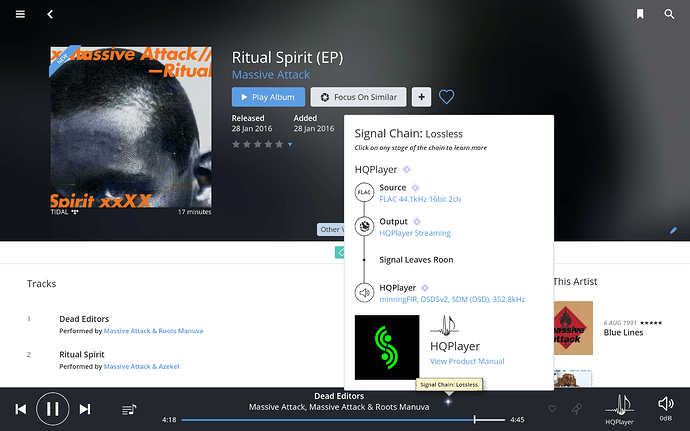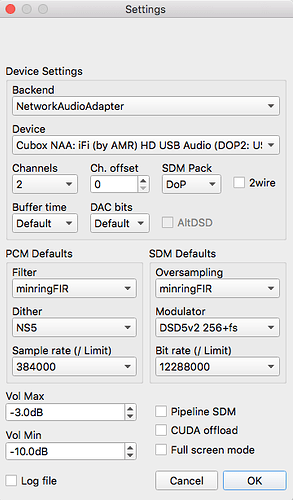Aaaaah (Foley: several pennies dropping). That explains why there isn’t a “cumulative filters” problem.
Well I can’t thank everyone enough for the outstanding, insightful, and information laden replies. Thank you.
After reading this, IMO I’d be a fool not to try it.
Well, I am going to be totally different here than others.
I use HQP as an endpoint on my 2012R2 Server to connect/talk to my DAC (USB), while I have my Roon Core on a separate Win10 Server running RoonServer. Both servers using AO. remote with iPad. This way my Roon Core and HQP are running on separate machines. Network is GB Ethernet/Fiber.
I do no upsampling with HQP as my settings are as follows: None, None, Auto, Auto. I have played around with many HQP settings and while each has its merits there is always something to give up sound quality wise IMO.
Watching units like the SonicOrbiter and the upcoming microRendu (waiting for cost).
@Wayne_Bull1: poly-sinc / ASDM5 mostly. Currently exploring poly-sinc-short. And at times I quite like the freshness of closed-form / DSD5v2 256+fs. All DSD256.
And yourself?
Thanks Rene,
Im currently using closed form-fast and ASDM5v2 but I do quite like straight PCM with no filters.
I’m usually poly-sinc-mp + ASDM7 + DSD128 with S-D chips. 384k PCM output for the ladder DACs.
I have simple tastes in up-sampling filters. Occasionally I’ll switch to the linear-phase variant for concert-hall type recordings.
I have been meaning to listen to closed-form. Maybe I’ll try that today.
A question for both of you–why do you both prefer the 5th order modulators? I can’t find a (scientific) reason why they should be better than the 7s, unless there’s a performance limitation involved.
I find ASDM5 a bit “darker” and my system tends to bright.
Hi Brian,
The 5s give a better soundstage on my system.
Poly-sinc with the ASDM modulators sounds slightly dark on my headphone setup. 5th order sounds a trifle ‘lighter’ than 7th.
That being said, I am starting to really enjoy the clean sound of minringFIR with DSD5v2 256+fs – I could still be weaning off PCM, I guess?
Maybe ask again in a month or two… 
In Roon should DSD256 actually show up as that?
I have sample rate set at 12288000 in HQPlayer but in Roon it shows as follows: -
That’s weird. Since the Auto setting in HQP, Roon has three ways of showing DSD256:
HQP set to auto:

HQP set to 11289600:
HQP set to 12288000:
Rene,
Could you drop me a screen shot of your HQPlayer settings so I can replicate them and try?
Cheers
Nothing special, I’m afraid:
The third pulldown is dependant on the source material (44.1 or 48 multiples) – or can be set to ‘Auto’ since HQP 3.13beta3 (when set to auto, the highest output value available is chosen automatically).
Thanks Rene, I’ll give that a try.
Just upgrading to 3.13b3
Rene
For some reason my iFi nano won’t play at all using the DSD5v2 256 filter.
It plays fine with all the others but not the 256 ones.
Any ideas
Cheers
You can’t trust that display with 3.13b3–Jussi just changed how it works when he added the Auto selectors, and exposed a new way to get the actual output rate/type that reflects what is actually going on.
I switched Roon to use the new mechanism last night, but that change hasn’t made it into a build (even on alpha) yet. It’ll go out whenever we make the next release.
Ok Cheers Brian
Sorted the DSD256 problem.
My ifi Nano needed updating to the latest 5.0a Strawberry firmware in order to play DSD256 on Mac.
Playing fine now.
I am not hearing any difference between Roon alone or with HQPlayer. My La Scala Aqua DAC is a NOS so maybe that makes a difference. I will experiment some more but I think my trial period must be running out shortly.
Just to explain some major differences between how typical DAC chips work vs how HQPlayer processes signal…
When RedBook content is played, typical DAC chip processing path looks like this:
[2x 63-tap FIR] -> [2x 31-tap FIR] -> [2x 15-tap FIR] -> [16x sample&hold] -> [3rd order sigma-delta modulator]
So after first stage rate is 88.2k, after second stage 176.4k and after third stage 352.8k. After that point, every sample is repeated 16 times (sample&hold aka zero-order-hold) reaching 5.6 MHz rate before entering the modulator. Samples are either 24-bit integer in older/inexpensive chips and 32-bit integer in modern more expensive chips. This processing means there are some notable rounding errors involved. There are also mirror images of the signal around every multiple of 352.8k rate. Each FIR stage has about half the taps, because it has half the number of master clock cycles to spend vs sample period. All processing is run synchronously to the sampling rate.
If you input at “2x” rate of 88.2/96, the first FIR stage is dropped out, if you input at “4x” rate of 176.4/192, the first and second FIR stages are dropped out. If you can input at “8x” rate of 352./384, all the FIR sections are dropped and only remaining S&H and SDM are in use.
What you can do with HQPlayer is alternatively:
[128x polyphase or closed-form] -> [7th order sigma-delta modulator]
for DSD output. Or alternatively:
[8x polyphase or closed-form]
for PCM output straight into S&H stage or a ladder DAC (like Metrum for example).
Samples are 64-bit floating point (with 80-bit used where necessary). There are significantly more clock cycles per sample available due to higher clock speed - 4 GHz CPU clock vs 25 or 50 MHz DAC clock. Processing is also asynchronous, so when necessary, the processing can decide to go back in time and recalculate things if it thinks that some adjustments need to be made, availability of large RAM enables this in practice.



